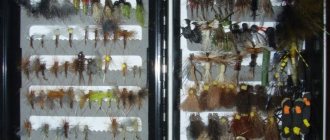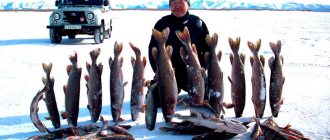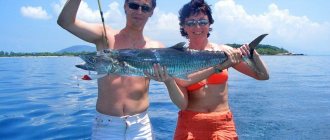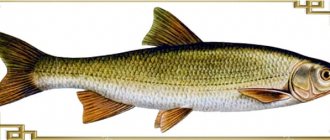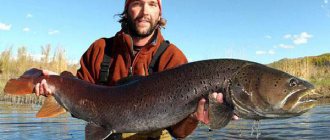Catfish is one of the ten most heat-loving freshwater fish, so the ability to catch it in winter raises deep doubts among many. But some fishermen claim that they have repeatedly, and therefore not by chance, managed to lift the mustachioed giants onto the ice even in mid-January. Tales? It’s unlikely, because to confirm their words they show photos in which they hold decent catfish in their hands, standing over the hole. And behind me is a white snow-covered background and trees covered with frost.
Of course, in our age of high technology, such a picture can be easily created using a graphic editor, but why would a fishing enthusiast need this? A real fisherman will not waste time on such nonsense; he devotes every free minute to his favorite pastime. Let's try to figure out whether catfishing is possible in winter. And to do this, let’s get to know this secretive river resident and his way of life.
Catfish pits
It’s no secret that for many anglers, “hunting” for catfish is considered a true summer activity. Of course, catching catfish using natural bait is a great pleasure on a quiet summer evening. But there is a certain part of fishermen whose opinions are similar: it is preferable to catch catfish with a spinning rod at a time when most of the fishermen have put down their gear until spring.
This opinion arose for a reason: a decrease in air temperature, and, consequently, water in reservoirs, has a beneficial effect on the concentration of catfish in pits, and therefore in specific places in the reservoir there is a massive accumulation of sleeping fish. So, when casting a silicone bait into catfish pits, the fish begins to intensively and reflexively grab the bait .
In the winter season, the greatest activity of catfish is observed at twilight . It is worth noting that it is during this period of time, as fishing practice shows, that one can see and feel the greatest aggression from catfish.
This is interesting: Catching catfish in May
When to catch catfish
The best time of day for catching catfish is the evening. But it bites not only at sunset, but also during the day if the weather is cloudy or snowy. In places where water does not freeze, it is better to catch it with a spinning rod.
The catfish bite remains equally active throughout the winter, so there are no special differences in catching it in December, January or February. But during the deep winter it is more difficult to catch it than at the beginning or end of winter, since it prefers not to move and does not leave the hole.
Features of behavior
Whether it is possible to catch catfish in winter is a subject of constant doubt among anglers. And I must say that these doubts are completely justified. Moreover, during the cold season, such fish are in a state of extreme peace and relaxation. Simply put, they are sleeping, and waking them up and stirring them up can be very difficult. Catfish go into wintering pits, which makes it very difficult to find and attract prey.
Their habits are quite predictable - maintaining a strict diet, lack of interest in nutrition. There is almost no bite. And it may even seem that winter fishing for catfish is completely devoid of prospects. But experienced fishermen still know how to overcome the difficulties that arise. True, even they are aware that in January and February there will be no fish to bite with rare exceptions, for example, in relatively warm reservoirs.
Habitats
Catfish prefers to swim at depth.
Catfish live only in fresh water bodies. It should be noted that representatives of the order sometimes end up in salt waters, but are not adapted to exist in them (the exception is the channel catfish).
Catfish species spend most of their lives at the bottom of reservoirs. They especially like silt and sand. Once in shallow water, fish experience stress. In addition, catfish react negatively to light and try to hide from it among algae, stones, and snags.
Silicone as the best bait
Silicone baits for catching catfish in winter can also be used to catch pike perch .
With the help of weighted lead heads, even in conditions of strong current, a silicone bait has every chance of being effective near the bottom. The streamlined shape of silicone baits allows for high-quality long-distance casts. Using silicone baits, you can successfully catch catfish in the winter, when there is severe frost and natural baits do not show energy and effectiveness. In winter, it is better to take silicone fish with you in sizes from 10 to 17 centimeters for catfish , since using large silicone baits in the winter is impractical, bites do not happen. However, in the summer, it is the large giant Twisters, the length of which can reach 28 centimeters, that are considered the best.
Color preferences when choosing a bait can be decided quite simply: when fishing in muddy water, it is advisable to use neon yellow silicone baits, while clean and transparent river water allows baits of green, golden and silver shades to best appear.
Excellent results in catching catfish in the winter season are shown by baits with sparkles, which remind catfish of the reflections of fish scales. At night, phosphorescent baits are popular . Before throwing such baits, they need to be saturated with the light of a flashlight. Thus, fishing even in complete darkness will be effective.
How to catch catfish in winter: choosing bait and fishing location
The success of winter fishing largely depends on the fishing location and the chosen bait. It is no secret that catfish are in a passive state in winter, they move little around the reservoir, and therefore catching catfish in winter is the pinnacle of fishing skill. Based on many years of observations, it became clear that catfish spend the entire winter in such places in the reservoir as:
- wintering pits;
- on half-dams;
- on washed out shores.
Depending on the size of the wintering hole, quite a few individuals can live in it. They are most often located at the depth of a lake or river, where the smallest circular current is observed. Usually the bottom in such places is not muddy, but hard. The deeper the hole, the greater the chance of catching a particularly large catfish.
When it comes to catching catfish in winter, every fisherman has his own opinion. Some believe that this activity is quite tedious and unprofitable. The passivity of the catfish and the difficulty in finding its wintering sites really complicate the task. However, due to the fact that catfish are severely deprived of food in winter, they quickly respond to bait.
What time and what to use to catch catfish in winter? Catching catfish using silicone bait with a jig is quite successful. Weighted baits are suitable as they sink well to the bottom. The color of silicone depends on the characteristics of the water in the pond. When catching a predator in muddy water, you should give preference to bright neon baits. If the pond is clean and the water is clear, then silver, gold or glitter-coated baits are suitable.
Hook up
3
Among the lead heads, we must pay tribute to the so-called Stand-Up, the fore-end of which is directed at an angle of 45 degrees relative to the plane. It is worth paying attention to the fact that with the help of this important quality the number of effective hooks increases significantly.
Based on the current and depth of the reservoir , fishing can be done with heads, the weight of which ranges from 15-35 grams. In the case when the river current is too intense, it is better to place a sinker in front of the lead head, for example, an “Olive” weighing 15-30 grams. This way, you can secure additional weight on the main line using rubber stoppers.
“Olives” are good when catching catfish because they, like a sled, slide along the surface of the bottom of a reservoir, raising the turbidity of silt. It is the dregs, in turn, that serves as an excellent element for attracting the attention of catfish.
What types of floats are there? Our article will answer this question.
This article will tell you about the best wobblers for trolling.
Regardless of which lead head is used in catching catfish, the hook must be sharp so that it can pierce the catfish’s mouth. In this regard, fishing with lead heads can be accompanied by equipment in the form of high-quality hooks.
Habitat - where catfish are found
Habitat of the common catfish
Catfish have a very wide habitat - they cannot be found only in the polar regions. In Russia you can find 10 species, including:
- Common or European catfish . Extremely common in Europe. Because The species is thermophilic; in Russia it lives only in subtropical and temperate climates. You can meet it in the reservoirs of the Caspian, Azov, Black and Aral seas. It reaches its greatest numbers in rivers such as the Volga, Don, Kuban, Ural, and Dnieper.
- Amur catfish . It is especially common in Japan, China and Korea. In Russia, the species lives mainly in the Amur basin. Distributed in the rivers of Primorye, lakes Khanka, Baikal and Gusinoe.
- Som Soldatova . Just like the previous species, it lives in the Amur basin. In addition, this fish is found in Lake Khanka and the Ussuri River.
Using bottom rigs and submerged floats in winter
The colder the water, the closer to the bottom the fish stay. At the bottom she also finds her food, since in cold weather something edible is rarely found in the water column and on its surface. It is clear that catfish also stay almost exclusively at the bottom. The best equipment for fishing from the shore is a rig with a submerged float. This float is put on the leash of the tackle; it lifts the bait and allows you to present it seductively at the very bottom. With this rig I use heavy lead weights or rocks tied to fairly thin line. This arrangement of bottom gear has two important advantages. Firstly, the heavy weight holds the bait securely on the river bottom. Secondly, due to its weight, the catfish that grabs the bait hooks itself during the first jerk.
The worm is considered the #1 bait for catfish. This bait works great in winter too. I put up to a dozen worms on the hook; this bunch plays great in the water and, combined with its natural smell, is a real treat for the catfish. You can additionally moisten the worms with some attractive attractant.
Live fish is one of the catchable bait options for winter catfish. In this case, it is important to offer the predator prey that would behave actively in cold water. For example, these are asp, pike perch, bream, rudd or crucian carp. I attach live bait to a two-hook rig. After the gear is delivered and the live bait is lowered to the bottom, the fishing rods are placed in the holders. The slack of the lines must be adjusted and the reel brakes must be tightened. This promotes self-hooking of the catfish after the first bite.
This is interesting: Catching pike perch using a balance beam
Catching catfish using baits and girders in winter
Despite the emergence of more and more new and natural-looking, most expensive artificial baits, the predator unerringly chooses live fish. In addition to its appearance, the fish has a whole gallery of bright and subtle odors, vital fluids, a spectrum of frequencies and vibrations to which any predator, including catfish, reacts. Therefore, live bait gear for catfish is the most practical and catchy for the winter period. In addition, fixed gear has another very important advantage: when they are placed in the right places, the fisherman moves away from them and does not create excessive noise on the ice, which the fish can hear very well, be it just the creaking of fishing boots on the snow. Any girder will confirm this, because when approaching a girder that was just in the grip of a predator, no matter how quietly the fisherman tries to sneak towards it, the pike will still hear him and try to leave, whistling as he spins the girder reel. And this despite the fact that the depth in this place can be ten meters.
Catfish fishing spot
It is believed that the most effective places for catching catfish are the fields between the groins (half-ponds). Catfish can find excellent shelter and a laid table in these places of the reservoir. The favorite stopping place for catfish in winter is the washed out front part of the semi-dam. You can also discover and make a pleasant surprise for yourself if you try to catch a catfish on the edge of the riverbed, where it is also very likely to land to hunt prey.
At twilight, the catfish goes to the inner part of the semi-dam and approaches the stone embankment for subsequent capture of prey. The following places on a body of water are excellent for catching catfish: entrances to ports, mouths of backwaters. In this place the fish also stands on the edge of the river bed . Note that only large catfish can be located in the riverbed itself.
You should also not ignore underwater natural obstacles, snags, etc., since catfish, like a real cunning and predatory fish, can ambush their prey.
If you have ever caught catfish with a quok, and also used natural baits, then most likely you have observed on the echo sounder monitor a catfish rising to the surface of the water behind the bait. Be sure to remember places like this! However, in winter, catfish are more likely to be caught on artificial bait.
How to prepare pearl barley for fishing? You can find out about this by reading our article.
In this article you will learn how to properly catch carp using cake.
If you are fishing from a boat , and also have an echo sounder with you, then as a guideline for successfully catching catfish, you can consider the places where small fish accumulate - potential victims of catfish.
Remember the truth: if there is a concentration of forage fish, it means that there is a catfish or several “mustached” representatives of the fish world nearby.
Fishing Features
Some enthusiasts catch catfish from the shore to the girder. For it to work, the structure must be properly fixed. It is easiest to choose places where there are strong trees. There is no need to rely on stakes and poles. No, you can catch a fish this way - only a freedom-loving predator is able to upend almost any pole and escape. It is worth considering that frosty weather reduces the metabolism of aquatic inhabitants. And if a catfish bites only once a day, then there is no point in blaming yourself - the point is how nature works. It is better to immediately prepare for the fact that the fishing will take a long time and may not even be successful at all.
Important Recommendations:
- Fishing in open water can be successful if the location of fish accumulation is accurately determined;
- It is advisable to use feeders among bottom gear;
- It is best to catch catfish near dams and discharge points of power plants (boiler houses);
- avoid using ropes with hooks (which is against the law and simply unsporting);
- wear warm clothes and thermal underwear;
- Check the ice carefully before going out on it.
In the next video you will find catching catfish with a fishing rod in winter.
Source
Tips and interesting facts
- When choosing jig heads, it is better to give preference to Stand Up models, in which the hook shank is directed at an angle of 45° in relation to the plane. Thanks to this arrangement, the number of successful hooks is much higher.
- When catching catfish in winter, the angler will need a lot of patience and perseverance, so if possible, try to choose clothes made from modern materials that allow you to stay in the cold for a long time.
- Regardless of the chosen method of catching catfish in winter, the bait should be presented in close proximity to the fish itself, so that the catfish must see the bait to attack.
Catfish baits
Fishermen have confirmed that fish such as catfish are best lured using artificial bait. The most preferable are silicone baits, which are made heavy by attaching a particle of lead to them. The color of such baits improves the visibility of fish, thereby focusing attention on their location. So, for example, if the water in which catfish are found is quite cloudy, then it is best to use bright yellow bait. For clear water, silver or green baits are suitable. Additionally, fishermen can use phosphorous baits, which can glow at night, thereby indicating the catfish to food. The size of the bait should not be more than 20 cm. Otherwise, the catfish will not be able to swallow it, and, therefore, will not swim to the fishing spot.
During the winter period, sleep is not very active. This allows fishermen to freely lure it to the fishing spot and hang bait on the hook that the fish can feast on. The main factor for successful catfishing in winter is the temperature of the reservoir in which the catfish is hiding at the bottom.
Catfishing is currently prohibited. However, poaching methods of catching such fish can be seen quite often today. People simply do not overdo this activity, catching fish for their own purposes and needs.
If you first familiarize yourself with the information that a fisherman may need, you can catch enough catfish in winter to enjoy the delicious meat of such fish. Winter fishing for catfish cannot be carried out anywhere in the reservoir, so you need to prepare for such a complex process in the summer.
Possible baits
During the colder months, catfish will only bite if the bait is directly in front of their face. The ideal choice, according to reviews from experienced fishermen, is a silicone decoy equipped with a weighted jig head. It can be quickly lowered into the water and vigorously pounded on the surface of the bottom. Such fluctuations are an excellent stimulus to perk up chilled fish. The vibrating tail should be no longer than 100 mm; its relatively short length is partly compensated by its bright, catchy color.
Tackle
Taking into account the peculiarities of the seasonal migration of this fish, it is much more difficult to catch it with a simple spinning rod than with a donk. In any case, a large predatory individual is very stubborn and persistent, often trying to free itself, making sharp jerks and maneuvers. Therefore, it is imperative to use first-class fishing gear and only very high-quality, highly durable gear. The choice of a specific device is determined solely by the convenience of fishing.
An attractive bait game without a light rod is unthinkable. Therefore, we have to prepare a sophisticated compromise, not forgetting about maintaining its strength. At the preparation stage, an ice pick will come in handy, because the wider the hole, the more convenient it is to act. The bagorik is also worth having with you.
Taste qualities of catfish
Comparison of the calorie content of catfish with other types of fish
Fish is popular in cooking because it has high taste. The calorie content of raw fillet is 95 kcal per 100 g. Catfish is very beneficial for the human body. It contains a lot of vitamins: D (12.5 mcg) and B12 (2.2 mcg), as well as phosphorus (209 mg), selenium (12.6 mcg).
The fillets of this fish can be stewed, fried, baked and dried. However, due to its habitat, the fillet has a strong muddy odor. For this reason, it is recommended to soak it in lemon juice, salt, soda or milk before cooking.
Old-fashioned way
It is better to determine where the catfish holes are in the summer. The deeper the hole, the more fish will live in it.
First, you have to cut a hole in the ice. Then throw the equipment into it with a self-propelled gun. If you cut the hole correctly, the effect will be immediate.
It is necessary to pull out the sauger carefully, as several fish may be caught on it at once. At the same time, there is no need to slow down, the catfish will slide off! To be on the safe side, pierce the catfish on the surface with a hook.
How does it winter
Catfish during wintering
Shortly before the onset of cold weather, representatives of the order become especially active and hunt a lot. Large species look for a suitable place for wintering as early as September. Starting from October or November, fish completely stop hunting. Catfish wait out the winter in pits, where they often gather in groups of 5 to 10 individuals. At the same time, they try to bury themselves in the mud.
Interesting: Inhabitants of the Red Sea - list, photos, videos, names and descriptions
